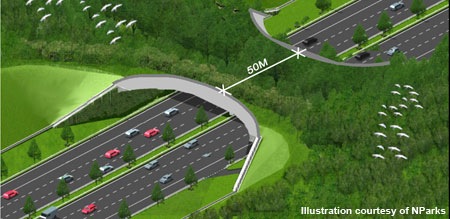This conservation corridor will offset the impact of fragmentation caused by the Bukit Timah Expressway which dissected the original continuous forest area into 2. Built over the Bukit Timah Expressway, the Ecolink is hourglass shaped and will be 50m at its narrowest point.

Some readings on conservation corridors
Simberloff, D. & J. Cox, 1987. Consequences and Costs of Conservation Corridors. Conservation Biology, 1(1): 63-71.
Fleury, A. M. & R. D. Brown, 1997. A framework for the design of wildlife conservation corridors with specific application to southwestern Ontario. Landscape and Urban Planning, 37(3-4): 163-186.
Article in The Straits Times 6 Sept 2009 by Grace Chua.
Bridge to link two nature reserves by 2013
By 2013, there will be a new green link between the Bukit Timah Nature Reserve and Central Catchment Area.
Conservationists had long bemoaned the separation of the two reserves by the Bukit Timah Expressway (BKE) since its construction in 1986.
The road prevented plant and animal species from moving between the two forest tracts.
The new eco-passage will arch over the 50m-wide BKE and be sited at a suitable narrow point between the reserves. Its construction was announced yesterday at the opening of the National Parks Board's Dairy Farm Nature Park.
A tender will be called at the end of this year and construction will start next year.
The bridge, 50m wide at its narrowest point and planted with dense trees resembling a forest habitat, could help populations of animals like the critically-endangered banded leaf monkey to recover.
Four to six years ago, there were thought to be fewer than 20 of the small dark-furred monkeys - a number too small to be sustainable - but now there are about 30 living around the Central Catchment Area.
The eco-link could help them migrate to Bukit Timah Nature Reserve to find other food sources.
A hiking trail at one edge will also enable humans to move between the reserves.
National University of Singapore conservation biologist Navjot Sodhi said of the bridge: 'Every plan to connect habitats is a good plan but how it pans out - only time will tell.'
'I hope NParks will do surveys to see how species are moving between the reserves,' he added.
Also launched yesterday was a national document which outlines Singapore's strategy for protecting its plants, animals and ecosystems.
The eco-link and Dairy Farm Nature Park are key components of the National Biodiversity Strategy and Action Plan, which describes five strategies:
- Safeguarding biodiversity.
- Taking biodiversity into account in policy-making.
- Improving knowledge of the natural environment.
- Raising public awareness of biodiversity.
- Strengthening local and international partnerships.
'It's not just scientists and government. Every individual plays a part in making conservation work in Singapore,' said Dr Lena Chan of NParks' conservation division.
Marine biologist Chou Loke Ming of the National University of Singapore said the plan recognises the importance of biodiversity and sets up a framework to protect it.
The plan is available online at www.nparks.gov.sg/nbsap.
Grace Chua
No comments:
Post a Comment